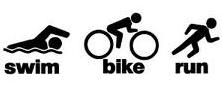For the past four weeks, we've been doing swim workouts that build aerobic endurance with spots of uptempo work to build speed. As we've said before, triathlon training is endurance training. This makes it difficult to train fast during the season.
However, we've now reached the offseason. Without any major races looming, we have a lower total training volume, and this allows us time to train harder, rest more, and hopefully get faster. This in turn sets us up for the resumption of base training when the new year arrives.
This week we're going to set our Cruise Interval. I hope you will forgive me, but in explaining this, I'm going to quote my own writing from Triathlon.About.Com:
"Your Cruise Interval (CI) is the interval per hundred yards of swimming that you can sustain during a prolonged intense effort. It is essentially your VO2 max swim pace, being the best pace that you can sustain over the course of a [moderately] long swim."
Knowing your CI is useful. For the past few weeks, I've been giving you intervals in terms of total overall rest, i.e. :30 rest or :45 rest or whatever. A better way to do it is in terms of your CI. For example CI + :15. So if your CI is 1:45 per 100 yards swimming, a set of 10 x 100 @ CI + :15 would actually be 10 x 100 @ 2:00. That makes sense, right?
Doing it this way lets me set a generic rest-goal for each interval that you can then easily tailor to your own fitness level. If I give you a set at CI + :15, I know you'll be resting about :15 per interval.
"[I]f you do a set of 10 x 100 on 2:00, that means that you have two-minutes to swim each hundred and rest, and that you’ll then leave for each 100—for every 100—at the top of a minute. If you’re leaving at the top of a minute for every interval, you’ll easily be able take your splits—and therefore gauge your effort—over time."
Calculating Cruise Intervals
We're going to do a set of 6 x 100 freestyle, holding our best six hundred yard pace. We'll take no noticeable rest between 100s. Instead, we'll leave at the nearest 5-second interval on the pace clock, taking note of how fast we do each interval. Whatever your last interval time turns out to be, that's your CI.
For example:
"[T]he first time I did this in college, it went something like this:
Came in at :54. Left at :55,
Came in at :57. Left at 1:00,
Came in at :58. Left at 1:00,
Came in at :59. Left at 1:00,
Came in at 1:00. Left at 1:05,
Came in at 1:02.
I rounded up to the nearest :05, and thus my first CI was 1:05."
Questions? As always, feel free to drop them in the comments.
Here's this week's workout.
Warm Up:
5 x 100 free @ :30 rest (easy)
200 kick
100 easy drill
Main Set: Set Your Cruise Interval
6 x 100 free (hard)
-- less than :05 rest per 100
100 easy drill
8 x 50 kick @ :10 rest
5 x 100 pull @ CI + :15
100 easy warm down
Notes:
That's it. Let me know how it went, okay?



No comments:
Post a Comment